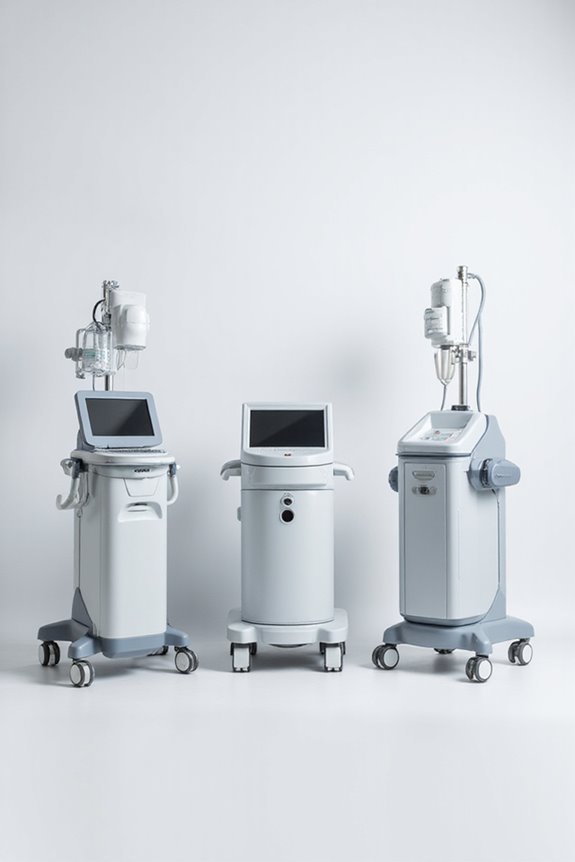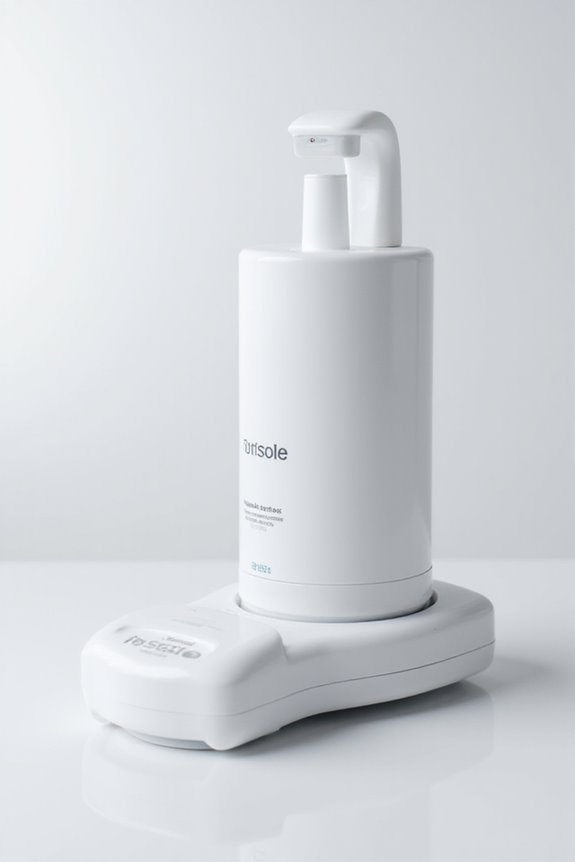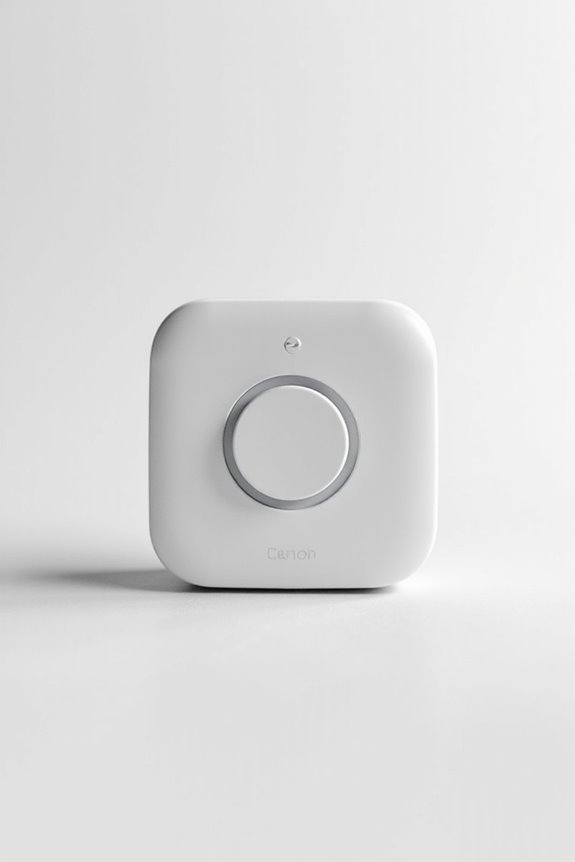Links below are affiliate links. We earn a commission on purchases at no extra cost to you. Although our opinions are based on curated research, we haven't used these products. Articles generated with AI. This article is for informational purposes only and does not constitute medical advice. Please consult a qualified professional for health-related questions.
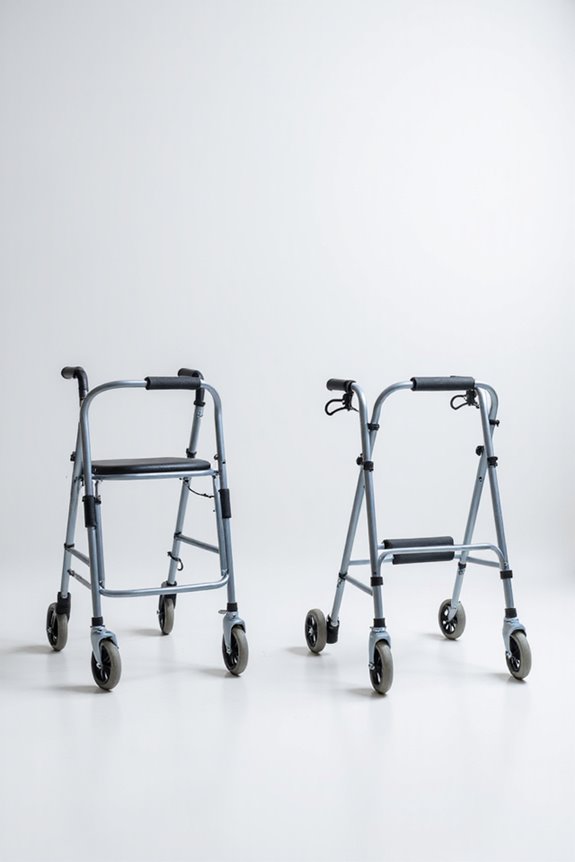
3 Best Walkers for Elderly: Enhance Mobility and Safety in 2025
For seniors seeking enhanced mobility and safety in 2025, consider these top walkers:
- Medical King Aluminum Lightweight Walker: Supports up to 350 lbs, with adjustable height and width for user customization.
- Pashion Blue Foldable Walker with Seat: Offers dual height adjustments and a breathable backrest, designed for comfort and support.
- Medline Rollator Walker with Seat: Capable of supporting 350 lbs, featuring a padded seat and under-seat storage for convenience.
Explore further to discover additional features and options.
Key Takeaways
- The Medical King Aluminum Lightweight Walker offers a high weight capacity of 350 pounds and adjustable height for user comfort and safety.
- Pashion Blue Foldable Walker features eight puncture-proof tires and an ergonomic design, enhancing mobility and providing a waterproof backrest for comfort.
- Medline Rollator Walker includes a padded seat and under-seat storage, making it convenient for resting and carrying personal items during outings.
- Key safety features in walkers include reliable braking systems, reflective strips for visibility, and sturdy frames for enhanced stability on various terrains.
- Consider adjustable walkers for proper fit; they ensure ease of use and accommodate different body sizes, promoting safety and comfort during mobility.
Medical King Aluminum Lightweight Walker for Seniors
Medical king Walkers for Seniors Aluminum Lightweight Walker with Wheels, Adjustable Width and...
- Walkers for Seniors
- Walker with Wheels, Rolling Walker
- Weighing Up To 350 Pounds
The Medical King Aluminum Lightweight Walker for Seniors is an ideal choice for individuals requiring mobility assistance, particularly due to its impressive weight capacity of up to 350 pounds.
Key Features
- Material: Made of durable aluminum
- Design: Lightweight with two front wheels
- Adjustability: Adjustable width and height for customization
Assembly and Portability
- Assembly: Easy to assemble for immediate use
- Storage: Folds flat for convenience
- Travel: Lightweight design enhances portability
User Feedback
- Safety: Users report feeling secure and confident
- Quality: Positive reviews regarding sturdiness and reliability
This walker accommodates a variety of users, including those recovering from injuries or surgeries.
Best For: The Medical King Aluminum Lightweight Walker for Seniors is best for individuals needing mobility assistance, including seniors and those recovering from surgery or injuries.
Pros:
- Easy to assemble and folds flat for convenient storage and travel.
- Lightweight aluminum construction supports up to 350 pounds, ensuring durability.
- Adjustable width and height allow for a customizable fit to enhance user comfort.
Cons:
- Some users may find width adjustments challenging in narrow doorways.
- Height requirements should be carefully considered for optimal use.
- Limited support in the rear due to only having wheels in the front.
Pashion Blue Foldable Walker with Seat for Seniors
No products found.
For seniors seeking mobility assistance, the Pashion Blue Foldable Walker with Seat stands out due to its robust construction and functionality. This walker is made from durable aluminum alloy, supporting weights up to 300 lb while weighing just 19.4 lb itself.
Key Features:
- Adjustability: Dual height adjustments (41-63 inches) and adjustable seat height (20-22 inches).
- Comfort: Ergonomically designed, 1.6-inch thick, waterproof seat with a breathable backrest.
- Mobility: Equipped with 8 puncture-proof tires and 360° rotating front wheels for better navigation.
Safety is paramount, featuring a sensitive braking system and reflective strips for visibility. Assembly is quick, under 10 minutes, and comes with lifetime support.
Best For: Seniors needing a reliable mobility aid that offers comfort and safety features for enhanced independence.
Pros:
- Lightweight design at 19.4 lb makes it easy to transport and maneuver.
- Comfortable seating with a thick, waterproof, and breathable backrest provides relief during rests.
- Safety features including a sensitive braking system and reflective strips enhance visibility in low light.
Cons:
- Weight capacity limited to 300 lb may not accommodate larger users.
- Minimal storage space with only one detachable bag might not suffice for all personal items.
- Limited color options for those seeking a more personalized style.
Medline Rollator Walker with Seat (Supports up to 350 lbs)
Sale
Medline Rollator Walker with Seat, Steel Rolling Walker with 6-inch Wheels Supports up to 350 lbs,...
- ROLLING WALKER EASILY FOLDS - Easily fold the Medline Steel Rollator Walker for convenient transport and storage.
- CONVENIENT STORAGE BAG UNDER SEAT - Simply lift up the padded seat to access the storage bag, perfect for holding your personal belongings
- HEIGHT ADJUSTABLE ARMS - allowing users to customize the fit of the rollator
Offering robust support for individuals weighing up to 350 lbs, the Medline Rollator Walker with Seat is an excellent mobility solution for those seeking reliable assistance.
Key Features:
- Steel Frame: Durable and sturdy construction
- Height-Adjustable Arms: Personalized fit for users
- Padded Seat: Provides comfort while resting
- Smooth-Rolling Wheels: 6-inch wheels for versatile use
- Convenient Storage: Under-seat bag for personal items
- Easy Transport: Folds compactly for storage
User-Friendly Design:
- Tool-Free Assembly: Simple and quick setup
- Navigates Narrow Spaces: Compact design fits through doorways
- Effective Brakes: Enhance user safety
Medline guarantees mobility and independence for all users.
Best For: Individuals needing mobility assistance who weigh up to 350 lbs.
Pros:
- Durable steel frame provides robust support for users.
- Compact and lightweight design allows for easy transport and navigation through narrow spaces.
- Padded seat and effective brakes enhance user comfort and safety.
Cons:
- May not perform well on very soft surfaces like sand.
- The storage bag under the seat might limit legroom when seated.
- Requires some upper body strength to engage brakes effectively.
Factors to Consider When Choosing Walker for Elderly
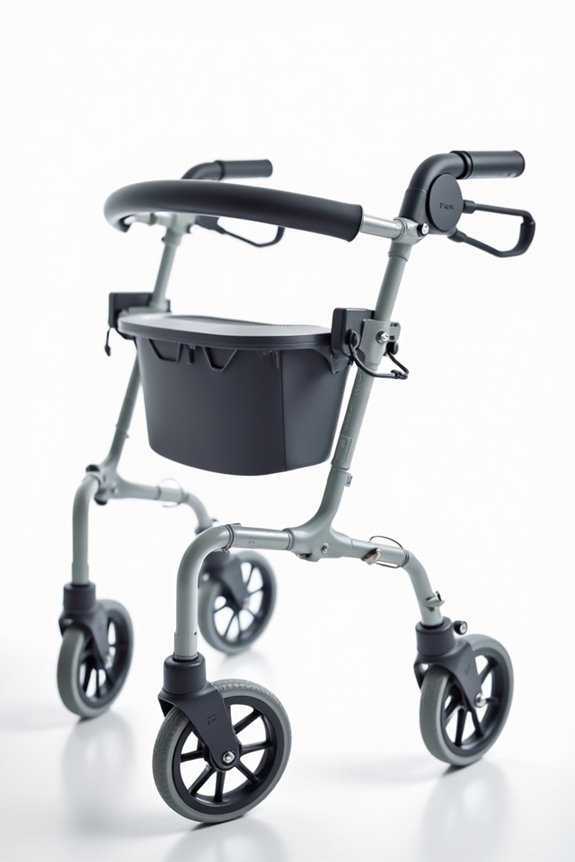
When choosing a walker for the elderly, it’s crucial to take into account several key factors. Weight capacity, adjustability, wheel types and sizes, frame material durability, and portability can greatly impact usability. Evaluating these aspects guarantees you select a walker that effectively meets needs and preferences.
Weight Capacity Considerations
Weight capacity is a critical factor in selecting a walker for the elderly.
- Most walkers support weight capacities ranging from 300 to 350 pounds.
- A higher weight capacity enhances stability and confidence for users of varying body types.
- Exceeding the weight limit can compromise the walker’s structural integrity, increasing the risk of accidents or falls.
When choosing a walker, assess the user’s current weight and anticipate potential weight changes over time to guarantee long-term suitability.
Additionally, many models include adjustable settings, allowing accommodation for different heights and weights, thereby improving user comfort and safety.
Selecting a walker that meets these weight capacity considerations is essential for maintaining mobility and safety for elderly users.
Adjustability and Customization Options
How important is adjustability when choosing a walker for the elderly?
Adjustability enhances comfort and stability. Consider these factors:
- Height Settings: Look for adjustable height features to guarantee a proper fit, essential for safety.
- Width Customization: Adjustable widths help accommodate different body sizes, allowing easier navigation through narrow spaces.
- Handle Height Levels: Multiple handle heights provide users with the best grip position for improved control and balance.
- Seat Height Adjustment: If the walker includes a seat, verify it can be adjusted for comfort during breaks.
- Ease of Adjustment: Choose models with intuitive mechanisms, simplifying adjustments for seniors with limited strength.
Prioritizing these features helps guarantee an effective and comfortable walking aid tailored to individual needs.
Wheel Types and Sizes
Selecting the right walker goes beyond adjustability; the wheel types and sizes are greatly influential in determining overall performance and usability.
- Larger Wheels (6 inches or more): Offer better stability, especially on uneven surfaces and outdoor terrains.
- Smaller Wheels: Facilitate easier navigation indoors or in tight spaces but may struggle on rough ground.
- 360° Rotating Front Wheels: Enhance ease of navigation, allowing for smoother turns in crowded or confined areas.
- Puncture-Proof Tires: Essential for outdoor walkers, these provide safety and durability against sharp objects or rough terrain.
- Weight Capacity: The combination of wheel size and type can impact overall stability, with heavier-duty models generally supporting more weight.
Consider these factors to guarantee maximum mobility and safety.
Frame Material Durability
When considering a walker, the choice of frame material plays an essential role in its durability and effectiveness. Key options include:
- Aluminum: Lightweight, rust-resistant, ideal for portability and outdoor use.
- Steel: Provides enhanced sturdiness, suitable for heavier users.
A walker’s weight capacity typically ranges from 300 to 350 pounds, largely dependent on the frame material used.
For longevity, look for quality construction features, such as:
- Welded joints: Offer better durability.
- Reinforced areas: Enhance resilience against wear and tear.
Regularly inspect the walker’s frame for signs of damage or wear. This guarantees ideal safety and performance, particularly for individuals who depend on walkers for mobility assistance.
Portability and Storage Ease
Portability and storage ease are essential factors to evaluate in selecting a walker, as they can greatly impact user experience and practicality.
- Folding Mechanism: Look for walkers that fold flat. This feature simplifies storage and transport.
- Weight Considerations: Lightweight models are usually easier to carry and maneuver, which is critical for elderly users or caregivers.
- Assembly: Tool-free assembly enhances user experience. It should be quick and simple.
- Folded Size: Assess the dimensions of the walker when folded to guarantee it fits in vehicles or storage areas.
- Portability Features: Evaluate features like built-in carrying handles or lightweight materials to facilitate travel and accessibility for users on the go.
Consider these aspects to guarantee a practical choice.
Comfort Features and Design
Comfort features and design are pivotal considerations in choosing a walker, as they greatly affect user satisfaction and usability.
- Ergonomic Design: Look for walkers with ergonomically designed seats and breathable backrests to enhance comfort during prolonged use.
- Adjustable Height: Adjustable height features guarantee users can customize the walker, promoting better posture and reducing strain.
- Padded Seats: Walkers with padded seats provide additional cushioning, beneficial during outings or long periods of use.
- Lightweight Materials: Assess the weight of the walker; lightweight designs facilitate ease of handling and portability, especially for seniors with strength limitations.
- Tire Quality: Opt for walkers with large, puncture-proof tires for slip resistance and stability, enhancing mobility and safety.
Terrain Compatibility
Selecting the right walker requires careful evaluation of terrain compatibility, as it directly impacts mobility and safety for the elderly.
Wheel Size:
– Larger wheels (around 8 inches) excel on uneven surfaces, whereas smaller wheels suit smooth indoor floors.
Maneuverability Features:
– Enhanced slip resistance and 360° rotating front wheels improve stability on various terrains, including slippery areas.
Braking System:
– A stable braking system with modes for free movement, deceleration, and complete stop is crucial for safety on different surfaces.
Frame Material:
– Steel frames provide durability for outdoor use; lightweight aluminum frames facilitate easier transport on smoother terrains.
Design Considerations:
– Confirm the walker allows for easy navigation through narrow doorways and crowded spaces, especially indoors.
Safety Features Importance
When choosing a walker for elderly individuals, safety features play a vital role in ensuring user stability and preventing falls. Consider the following essential features:
- Reliable Braking System: Important for preventing falls and ensuring stable use.
- Reflective Strips: Enhance visibility at night, reducing accident risks in low-light conditions.
- Sturdy Frame: A robust design that supports higher weight capacities contributes to user safety and confidence.
- Adjustable Height Settings: Prevent strain, improve posture, and minimize injury risks.
- Large, Slip-Resistant Wheels: Designed for various terrains, these enhance stability and maneuverability, essential for uneven surfaces.
Prioritizing these safety features can greatly improve the walking experience for elderly users, making mobility safer and more efficient.
Frequently Asked Questions
How Do I Maintain and Clean My Walker?
To maintain and clean your walker, follow these steps:
- Daily Cleaning: Wipe down handgrips and frame with a damp cloth. Use mild detergent for stubborn stains.
- Periodic Inspection: Check for loose screws and tighten as needed.
- Wheel Care: Inspect wheels for debris; clean with a brush to guarantee smooth movement.
- Storage: Store in a dry, cool place to prevent rust and deterioration.
Can Walkers Be Customized for Specific Needs?
Yes, walkers can be customized for specific needs. Key customization options include:
- Height Adjustments: Guarantees the walker fits user’s height properly.
- Weight Capacity: Select designs that accommodate user weight for increased stability.
- Accessories: Attach trays, baskets, or cup holders for convenience.
- Wheels: Choose between fixed or swivel wheels based on intended use.
With these adjustments, you can enhance both mobility and overall safety during use.
What Is the Average Lifespan of a Walker?
What do you think is a walker’s typical lifespan? On average, walkers last between 5 to 10 years, depending on materials and usage. Here are some factors influencing their durability:
- Material: Aluminum and steel provide different longevity.
- Usage: High-frequency use may accelerate wear.
- Maintenance: Regular checks guarantee functionality and safety.
Ultimately, prioritizing quality and routine inspection can maximize your walker’s lifespan, assuring reliable mobility assistance when you need it most.
Are There Walkers With Advanced Features for Seniors?
Yes, there are walkers with advanced features for seniors. These include:
- Smart Technology: Some models have built-in sensors that monitor patterns and alert caregivers.
- Adjustable Height Settings: This feature accommodates various user heights, enhancing comfort.
- Built-in Seats: Allows for resting when needed.
- LED Lights: Improves visibility in low-light conditions.
These advancements greatly enhance safety and mobility, making walking easier for seniors. Choose models based on specific needs and preferences.
How to Encourage Elderly Individuals to Use Walkers?
To encourage elderly individuals to use walkers, highlight the benefits of enhanced mobility. For instance, consider a 75-year-old who, after using a walker, improved her daily activity level by 30%.
Key strategies include:
- Demonstrating proper usage.
- Emphasizing safety features.
- Offering trials to build comfort.
Statistics show that 60% of seniors using walkers report increased confidence.
Ultimately, creating a supportive environment fosters regular use and encourages independence.



